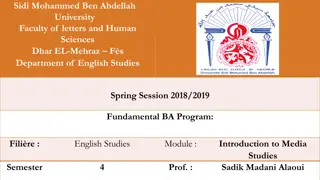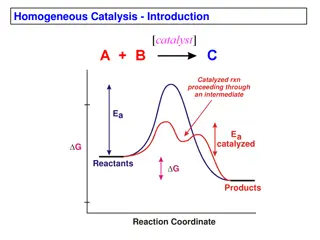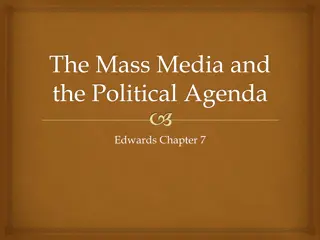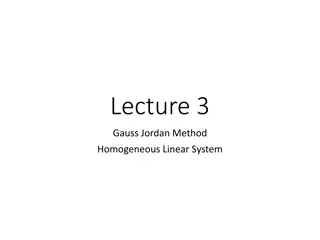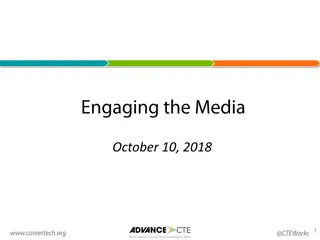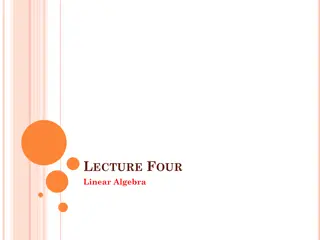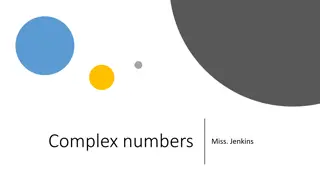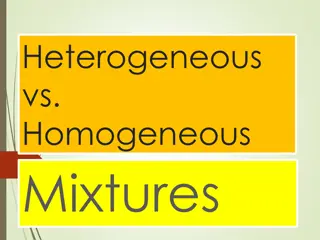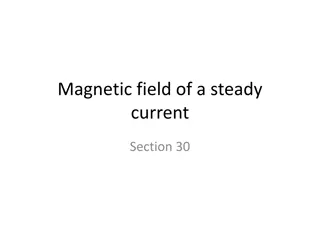Understanding Complex Wavevectors in Homogeneous Media
Exploring the concept of complex wavevectors in a homogeneous medium, this content delves into monochromatic waves, Maxwell equations, wave propagation, and the relationship between material properties and wave behavior. It discusses how the complex nature of wavevectors impacts fields, damping, and the direction of wave propagation, highlighting the nuances of wave behavior in different mediums.
Download Presentation

Please find below an Image/Link to download the presentation.
The content on the website is provided AS IS for your information and personal use only. It may not be sold, licensed, or shared on other websites without obtaining consent from the author. Download presentation by click this link. If you encounter any issues during the download, it is possible that the publisher has removed the file from their server.
E N D
Presentation Transcript
A plane monochromatic wave Section 83
1. Monochromatic field (dielectric medium) Maxwell equations These two equations are complete: The other two Maxwell equations follow
Assume a homogeneous medium. Eliminate H div D = 0 (No extraneous charge) Wave equations Eliminate E instead
2. A plane wave in an infinite homogeneous medium Plane wave in vacuum has spatial dependence eik.r, with real wave vector k A wave propagating in matter has a complex wave vector k = k + i k Real numbers
3. Relation between k, k and material properties for plane wave Exp[i k. r] We ll use the following relation to transform the Maxwell curl equations. Had New Next, eliminate E and H (HW) to find relation for the complex wavevector k + i k
Ways for wavevector of monochromatic wave to be complex 1. If or is complex, then k must be complex. 2. If and are real but one of them is negative, then k 2 must be nonzero and k .k = 0. Then k is complex. 3. If both and are real and positive, k can be real, but it still might be complex if k .k = 0 but k is nonzero and k 2> k 2.
4. What was a plane wave in vacuum, Exp[i k. r], is more complicated when k is complex If k = k + i k , damping Planes perpendicular to k are planes of constant phase k Planes of constant amplitude are those perpendicular to k Direction in which wave is damped doesn t necessarily coincide with direction of propagation. Surface of constant E(r,t) are not necessarily planes: inhomogeneous plane waves . These can occur even in homogeneous media where and are spatially uniform.
5. Relations between complex wavevector and complex fields k, E, H are all complex. The significance of these relations is not as obvious as it was in vacuum, where E, H, and k were mutually perpendicular and E = H. In medium, E does not need to be perpendicular to the propagation direction, e.g. surface plasmon polaritons.
6. In the special case of transparent homogeneous medium, there is no damping, so k = 0. The wavevector is real. refractive index Then from H = ck X E and k.E = 0, E, H, and k are mutually perpendicular. (Both Re and Im parts) If k = k l (l = unit vector) Looks like energy densities are the same, but be careful
Electric and magnetic energy densities for monochromatic wave are not the same when there is dispersion That s because Instead (80.11) Not equal if there is dispersion
7. Electromagnetic wave energy propagates at the group velocity For non-absorbing media k = n /c (83.7) Mean value of Poynting vector If there is no dispersion, n is independent of . Then u = c/n (section 75).
8. Now allow absorption but restrict k k Surfaces of constant field are now planes to k: homogeneous plane wave
9. Complex refractive index Let complex k l (unit direction vector) Define a complex length k so that k = k l Write complex number in standard form n = index of refraction (real) = absorption coefficient (for field, not intensity.) More conventionally called extinction coefficient . Gives rate of damping of electric field wave. Caused by dissipation if or is complex Damping occurs without dissipation if is real but negative (evanescent wave).
10. Relations between complex index and complex permittivity At optical frequencies, 1. Inverse relations
Conductors at low enough frequency have imaginary permittivity Then In quasi-static regime, dispersion is small
11. Homogeneous plane wave in lossy medium Complex H, E, and k are mutually perpendicular If = 1 Instead of equal as in vacuum. H-=field magnitude is times E-field magnitude H and E are Arctan( /n) out of phase, instead of in phase For conductor at low frequency n = and = Arctan[1] = /4.







